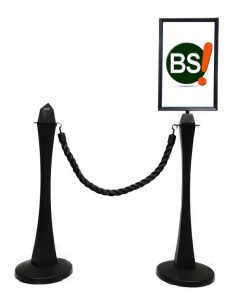 Maintaining Control of Fast Growing Cities with Crowd Control Equipment: Boulevard Supply and Stanchion Masters® Leading the Way
Maintaining Control of Fast Growing Cities with Crowd Control Equipment: Boulevard Supply and Stanchion Masters® Leading the Way
As cities around the USA continue to experience rapid growth, maintaining control and order becomes increasingly challenging. With the influx of people, traffic, and events, it is crucial for city authorities to have effective crowd control measures in place. This is where crowd control stanchions, traffic cones, and delineators play a vital role. Boulevard Supply, in partnership with their renowned Stanchion Masters® brand, offers a comprehensive range of crowd control equipment that can help cities maintain order and safety.
Fast-growing cities often face a multitude of challenges when it comes to managing crowds and traffic. From large-scale events to everyday pedestrian flow, ensuring public safety and smooth operations is paramount. Crowd control stanchions are an essential tool in achieving this goal. These versatile barriers can be used to guide foot traffic, create queues, or cordon off restricted areas. By strategically placing stanchions, cities can effectively manage crowds and prevent chaos.
Traffic cones and delineators are equally important in maintaining control on busy city streets. These highly visible markers help direct traffic, indicate road closures or detours, and provide clear guidance to drivers. With the right placement of traffic cones and delineators, cities can ensure the safety of both motorists and pedestrians.
Boulevard Supply has emerged as a leading provider of crowd control equipment, offering a wide range of products designed to meet the specific needs of fast-growing cities. Their Stanchion Masters® brand further solidifies their position as an integral partner in maintaining control.
 Stanchion Masters® stanchions are known for their durability, versatility, and sleek design. Made from high-quality materials such as stainless steel and WPC, these stanchions can withstand the rigors of daily use in busy urban environments. Whether it’s managing crowds at a concert venue or guiding pedestrians through a bustling city center, Stanchion Masters® stanchions provide a reliable solution.
Stanchion Masters® stanchions are known for their durability, versatility, and sleek design. Made from high-quality materials such as stainless steel and WPC, these stanchions can withstand the rigors of daily use in busy urban environments. Whether it’s managing crowds at a concert venue or guiding pedestrians through a bustling city center, Stanchion Masters® stanchions provide a reliable solution.
In addition to their durability, Stanchion Masters® stanchions offer various customization options. Cities can choose from a range of colors, belt lengths, and accessories to suit their specific needs. This flexibility allows for seamless integration into existing urban aesthetics while maintaining control and order.
Boulevard Supply’s commitment to customer satisfaction is another reason why they are the go-to partner for crowd control equipment. Their knowledgeable team is always ready to assist cities in selecting the right products for their unique requirements.
10 of the Fastest Growing Cities in the USA: The Pros and Cons of Growth
1. Phoenix, Arizona: With its affordable housing and growing job market, Phoenix has experienced rapid population growth. However, this has led to increased traffic congestion and strain on infrastructure.
2. Austin, Texas: Known for its vibrant culture and thriving tech industry, Austin has seen a surge in population. This has resulted in skyrocketing housing prices and increased competition for jobs.
3. Seattle, Washington: The booming tech sector in Seattle has attracted many newcomers, but the rising cost of living and homelessness have become major concerns.
4. Denver, Colorado: With its scenic beauty and outdoor recreational opportunities, Denver has become a popular destination. However, the influx of residents has caused a strain on affordable housing options and increased pollution levels.
5. Atlanta, Georgia: Atlanta’s strong economy and diverse job market have attracted numerous individuals. However, the rapid growth has resulted in worsening traffic congestion and urban sprawl.
6. Charlotte, North Carolina: As a major financial center, Charlotte has experienced significant growth. The downside includes increased housing costs and strain on public services like schools and healthcare.
7. Orlando, Florida: With its world-famous theme parks and tourist attractions, Orlando has seen a surge in population. This has led to increased traffic, overcrowding, and a strain on local resources.
8. Tampa, Florida: Tampa’s warm climate and growing job market have made it an appealing destination. However, the rapid population growth has put pressure on public transportation systems and created a housing shortage.
9. Nashville, Tennessee: Known as the “Music City,” Nashville has witnessed a rapid increase in population due to its thriving entertainment industry. This growth has brought about rising property prices and increased traffic congestion.
10. Salt Lake City, Utah: Salt Lake City’s strong economy and outdoor recreational opportunities have attracted many newcomers. However, the rapid growth has led to increased housing costs and challenges in maintaining the city’s unique character.
Pros and Cons of an Increasing Population:
Pros:
1. Economic growth: A larger population can contribute to economic expansion through increased consumer demand, job creation, and tax revenue.
2. Cultural diversity: A growing population can enhance cultural diversity, fostering new ideas, traditions, and perspectives.
3. Innovation and creativity: With more people comes a larger talent pool, leading to increased innovation and creativity in various industries.
4. Infrastructure development: A rising population often necessitates infrastructure improvements, such as transportation systems, schools, and healthcare facilities.
Cons:
1. Strain on resources: An increasing population can strain resources such as housing, water, energy, and healthcare, leading to shortages and increased costs.
2. Traffic congestion: More people can result in overcrowded roads and increased commute times, negatively impacting the quality of life for residents.
3. Environmental impact: A growing population can lead to increased pollution, deforestation, and habitat destruction, posing a threat to the environment.
4. Social issues: Rapid population growth can exacerbate social issues like inequality, crime rates, and overcrowding in schools and public spaces.
What Happens if Population Growth Occurs Too Fast?
If population growth occurs too fast, it can lead to several negative consequences:
1. Overburdened infrastructure: Rapid growth can strain existing infrastructure, leading to inadequate housing, insufficient public services, and overwhelmed transportation systems.
2. Housing crisis: A sudden increase in population can cause a shortage of affordable housing, driving up prices and making it difficult for residents to find suitable accommodations.
3. Environmental degradation: Quick population growth can put pressure on natural resources, resulting in increased pollution, habitat destruction, and a decline in overall environmental quality.
4. Social unrest: If not properly managed, rapid population growth can exacerbate social tensions, inequality, and crime rates, leading to social instability within a community.
5. Decreased quality of life: Overcrowding, increased competition for resources, and strained public services can negatively impact the overall quality of life for residents.
In conclusion, while rapid population growth in cities can bring numerous benefits such as economic growth and cultural diversity, it also presents challenges. The cons of an increasing population include strain on resources, traffic congestion, environmental impact, and social issues. If population growth occurs too fast, it can lead to overburdened infrastructure, housing crises, environmental degradation, social unrest, and decreased quality of life for residents. Therefore, it is crucial for cities to plan and manage growth effectively to ensure sustainable development and a higher standard of living for their residents.
Large Cities That Have Successfully Handled Rapid Growth
Las Vegas, often referred to as the “Entertainment Capital of the World,” is a prime example of a city that has successfully managed rapid growth. This bustling desert metropolis has experienced exponential population expansion and economic development over the past few decades. However, Las Vegas is not the only city that has adeptly handled rapid growth. Let us explore two other metropolitan areas that have achieved similar success by efficiently managing their growth.
Dubai, United Arab Emirates:
Dubai is renowned worldwide for its rapid urbanization and impressive skyline. Over the past few decades, this Middle Eastern city has transformed from a small fishing village to a thriving global business hub and tourist destination. The success of Dubai’s rapid growth can be attributed to several factors:
a) Visionary Planning: The government of Dubai implemented strategic long-term plans to facilitate growth and attract investments. Initiatives like “Dubai Strategic Plan 2015” and “Dubai 2021 Plan” emphasized infrastructure development, economic diversification, and sustainable urbanization.
b) Infrastructure Investment: Dubai invested heavily in infrastructure development to support its expanding population and economy. The construction of modern roads, bridges, airports, and metro systems ensured efficient transportation networks throughout the city.
c) Business-Friendly Policies: Dubai adopted business-friendly policies, including tax incentives, free trade zones, and simplified bureaucracy, that encouraged both local and international companies to establish their presence in the city. This resulted in a thriving business ecosystem, attracting talent and driving economic growth.
Singapore:
Singapore, a small island nation in Southeast Asia, is widely recognized for its remarkable transformation from a developing country to a global economic powerhouse. The city-state has managed its rapid growth effectively by focusing on the following key aspects:
a) Urban Planning: Singapore implemented meticulous urban planning, ensuring a balanced mix of residential, commercial, and green spaces. The Housing and Development Board (HDB) successfully provided affordable public housing for the growing population, fostering social cohesion and inclusivity.
b) Efficient Transportation: Singapore invested in an extensive public transportation system, including an extensive metro network, efficient bus services, and well-connected cycling paths. This integrated and accessible transportation system reduces congestion and promotes sustainable mobility.
c) Economic Diversification: Singapore strategically diversified its economy, becoming a global financial center, a hub for technology and innovation, and a major logistics hub. This diversification attracted international investments, created job opportunities, and ensured economic resilience.
In conclusion, these examples demonstrate how Las Vegas, Dubai, and Singapore have successfully managed rapid growth by implementing visionary planning, investing in infrastructure, adopting business-friendly policies, and focusing on urban planning and economic diversification. These cities serve as shining models for effective growth management strategies, ensuring sustainable development and enhanced quality of life for their residents.
